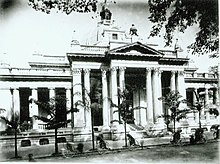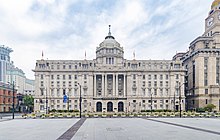
HSBC Holdings plc (Chinese: 滙豐; acronym from its founding member The Hongkong and Shanghai Banking Corporation) is a British universal bank and financial services group headquartered in London, England, with historical and business links to East Asia and a multinational footprint. It is the largest Europe-based bank by total assets, ahead of BNP Paribas, with US$2.919 trillion as of December 2023.[7] In 2021, HSBC had $10.8 trillion in assets under custody (AUC) and $4.9 trillion in assets under administration (AUA).[4]
HSBC traces its origin to a hong trading house in British Hong Kong. The bank was established in 1865 in Hong Kong and opened branches in Shanghai in the same year.[1] It was first formally incorporated in 1866.[8] In 1991, the present parent legal entity, HSBC Holdings plc, was established in London and the historic Hong-Kong-based bank from whose initials the group took its name became that entity's fully-owned subsidiary.[9][10][11] The next year (1992), HSBC took over Midland Bank and thus became one of the largest domestic banks in the United Kingdom.
HSBC has offices, branches and subsidiaries in 62 countries and territories across Africa, Asia, Oceania, Europe, North America, and South America, serving around 39 million customers.[12] As of 2023, it was ranked no. 20 in the world in the Forbes rankings of large companies ranked by sales, profits, assets, and market value.[13] HSBC has a dual[14] primary listing on the Hong Kong Stock Exchange and London Stock Exchange and is a constituent of the Hang Seng Index and the FTSE 100 Index. It has secondary listings on the New York Stock Exchange, and the Bermuda Stock Exchange.
HSBC has been implicated in a number of controversies and the bank has been repeatedly fined for money laundering (sometimes in relation to major criminal organizations such as the Sinaloa cartel)[15] or setting up large scale tax avoidance schemes.






After the British established Hong Kong as a crown colony in the aftermath of the First Opium War, merchants from other parts of the British Empire, now in Hong Kong, felt the need for a bank to finance the growing trade, through Hong Kong and sometimes also through Shanghai, between China and India, the rest of the British Empire and Europe, of goods, produces and merchandises of all kinds, but especially opium, cultivated in or transited (re-exported) through the Raj.[16][17]
The founder, Thomas Sutherland of the Peninsular and Oriental Steam Navigation Company, wanted a bank operating on "sound Scottish banking principles". Still, the original location of the bank was considered crucial and the founders chose Wardley House in Hong Kong since the construction was based on some of the best feng shui in colonial Hong Kong.[18]
After raising a capital stock of HK$5 million, the bank commenced operations on 3 March 1865. It opened a branch in Shanghai in April of that year and started issuing locally denominated banknotes in both the Crown Colony and Shanghai soon afterwards. The bank was incorporated in Hong Kong as The Hongkong and Shanghai Banking Corporation by the Hongkong and Shanghai Bank Ordinance (Numbers 2 and 5 of 1866),[19] and a branch in Japan was also established in Yokohama in 1866.[1][20] Shares of the bank were one of 13 securities initially traded on the Shanghai Stock Exchange, and were traded on that exchange until the Japanese closed the exchange in 1941.[21]




Sir Thomas Jackson became chief manager in 1876. During his twenty-six-year tenure, the bank became a leader in Asia. A period of expansion followed, with new buildings constructed in Bangkok (1921), Manila (1922) and Shanghai (1923), and a new head office building in Hong Kong in 1935. Bank note issuance displaced other forms of the era and of the region, such as silver taels, due to political and economic instability. HSBC gained significant influence as a result.[23]
Get the best experience with Kemon app!